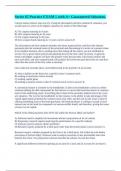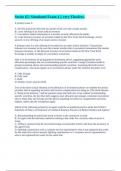Series 65 Practice EXAM || with A+ Guaranteed Solutions.
Current market interest rates are 6%. Using the discounted cash flow method of valuation, you
would expect to arrive at the highest valuation for which of the following?
A) 7% coupon maturing in 9 years
B) 10% coupon maturing in 10 years
C) 5% coupon maturing in 20 years
D) Zero-coupon bond maturing in 11 years correct answers B
The discounted cash flow method considers the future expected free cash flow (the interest
payments plus the eventual return of the principal) and discounting it to arrive at a present value.
In its simplest iteration, this is nothing more than taking all the money you are scheduled to
receive over a given future period and adjusting that for the time value of money. In general,
bonds with higher coupons will have the greatest value because they will clearly produce the
most cash flow, and zero-coupon bonds will produce the lowest because they have no cash flow
other than the return of the face value at maturity.
One would not normally place convertible bonds in the portfolio of an investor
A) who is bullish on the future for a specific issuer's common stock
B) seeking to maximize current income
C) seeking capital gains
D) seeking a position senior to that of common stock correct answers B
A conversion feature is a benefit to the bondholder. It allows the bondholder a choice to either
continue holding the debt represented by the bond or to convert the bond into shares of common
stock of the underlying issuer. Everything that is done in the securities industry has to be a win-
win situation. The win for the bondholder in this instance is the ability to take advantage of the
capital appreciation potential the common stock may offer, and the win for the issuer is that by
offering something extra to the bond purchaser, the bond purchaser is willing to accept a lower
interest rate on the bond (as compared to a nonconvertible bond), and therefore, giving the issuer
a lower cost of capital.
Which of the following items does NOT fall within the Section 28(e) safe harbor?
A) Software used to simplify the investment adviser's preparation of its tax returns
B) Proprietary research reports analyzing the performance of a specific industry
C) Software used to analyze client's portfolios
D) Research reports prepared by a third party other than the broker-dealer correct answers A
Research reports, whether prepared by the firm or by a third party, fall within the safe harbor
provisions of Section 28(e). Software used to analyze securities is also permissible since that
benefits the client. Tax preparation software benefits the adviser, but not the client.
A significant difference between opening an account for a trust and an account for an estate is
,A) the standard of prudent investing applies to trusts, but not to executors
B) banks can be named as trustees for a trust, but not as an executor
C) only the estate has beneficiaries
D) the trust account will generally be active for a much longer period of time correct answers D
Trusts can be set up to run for many years; the executor's job is over once the estate has been
settled.
Richard, Tim, Sam, and Fred have a regular golf foursome every weekend. During one of their
outings, they decide it is time they did something constructive with their money by opening an
account with a brokerage firm. If the account is opened tenants in common, suitability
information would be required on
A)
each of the individuals, and if married, their spouses
B)
only that individual with the authorization to trade the account
C)
each of the four individuals
D)
whichever person has been designated by the group as its spokesman correct answers C
On any joint account, it is required to obtain suitability information on all of the account owners.
Prudent Asset Construction Enterprises (PACE) has offices in states X, Y, and Z. On their last
annual updating amendment, they reported AUM of $218 million. In which of the following
instances would PACE be receiving a substantial prepayment of fees?
A)
$1,600, paid at the first of each quarter
B)
$1,600, paid one year in advance
C)
$600, paid six or more months in advance
D)
$10,000, paid monthly correct answers B
First of all, this is an SEC registered IA, so we have to go by the federal numbers. Those are
more than $1,200, six or more months in advance. The $600 would have been substantial if
PACE was state-registered. Although the other two choices are above $1,200, they are not
prepaid for at least six months.
All of the following would decrease the U.S. balance of payments deficit EXCEPT
A)
,a decrease in purchases of U.S. securities by foreign investors
B)
a decrease in imports of foreign goods into the U.S.
C)
an increase in exports of domestic goods from the U.S.
D)
a decrease in dividend payments by U.S. companies to foreign investors correct answers A
Anything that will bring foreign money to the U.S. will decrease the balance of payments.
Foreign investors pulling their money out of the U.S. or investing less in the U.S. will increase
the deficit.
Popular strategies used by bond investors to mitigate the effects of changes in interest rates
would include any of the following EXCEPT
A)
the laddering strategy
B)
the barbell strategy
C)
the strategy of lengthening the maturities of their holdings
D)
the bullet strategy correct answers C
For those concerned about the effects of interest rate fluctuations on their portfolio, increasing
the length of the maturities would increase, rather than decrease, the risk.
Daphna works for Automated Asset Allocators (AAA), an investment adviser having offices in
States D, E, and F and registered with the SEC. Daphna spends most of her time in an office in
State D, but, once every other week, she goes to the branch in State E. Daphna would be exempt
from registration as an IAR in which of the following states?
A)
State E, where she has no retail clients
B)
State F, where she has 227 retail clients
C)
Daphna would have to register in all three states
D)
States E and F correct answers B
As an IAR with a federal covered investment adviser, Daphna only has to register in those states
in which she maintains a place of business. That means registering in States D and E. The
number of clients is irrelevant.
, Both state-registered and federal covered investment advisers have brochure delivery
requirements. One significant difference between the two is that
A)
state-registered advisers who do not deliver the brochure at least 48 hours prior to contract
signing must offer a 5-day penalty free withdrawal.
B)
federal covered advisers are exempt from the brochure delivery requirements to investment
company clients while state-registered advisers are not.
C)
state-registered advisers must deliver the brochure within 90 days of the end of their fiscal year
while covered advisers have 120 days.
D)
state-registered advisers who do not deliver the brochure at least five days prior to contract
signing must offer a 48 hour penalty free withdrawal. correct answers A
State-registered investment advisers who do not deliver the brochure at least 48 hours prior to
entering the contract must offer a penalty-free withdrawal of five days. There is nothing
comparable to that in the federal law. Both have the 120-day delivery requirement, and state-
registered investment advisers cannot have investment companies as clients.
Weak-form efficient market hypothesis
A)
implies that technical analysis is not worthwhile.
B)
implies that fundamental analysis is not worthwhile.
C)
implies that inside traders cannot earn superior risk-adjusted returns.
D)
reinforces the value of technical analysis. correct answers A
The weak form implies that information contained in historical stock prices is fully incorporated
into current stock prices; therefore, technical analysis (the study of historical prices and volume)
is not worthwhile in predicting future prices. This form neither refutes fundamental analysis nor
implies that traders using insider information cannot earn superior profits.
The term alternative investment would least likely apply to
A)
exchange-traded notes (ETNs)
B)
leveraged ETFs
C)
inverse ETFs
D)





